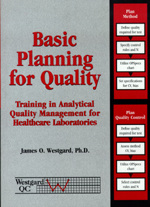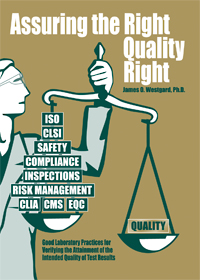Basic Planning for Quality
QP 5: Defining Quality Requirements
Now that we agree that we need to plan quality, and that we've decided on a practical process to do it, there's just one hitch left: Where do we find quality requirements? How do we reconcile CLIA PT criterion, clinical decision levels, analytical quality requirements, biological variation, etc.? What does it mean when a salesman says his instrument is "state of the art"? What state? What art? Dr. Westgard introduces a system of quality standards to allow you to determine the quality required for every test. (Preview)
- Self-assessment exercise
- Difficulties with quality requirements
- A system of quality standards
- Answers to self-assessment exercise
- References
Here's a common management problem that requires quality-planning skills. You are looking at a new! more reliable! higher-capacity! larger menu! faster! simpler-to-operate! and less costly! analyzer (I read the advertisements too). Let's assume one of the tests to be performed is cholesterol.
- What precision and accuracy is needed for a cholesterol method?
- What QC procedure would you use to monitor the quality of routine results?
These are basic questions that you need to answer if you are to manage the analytical quality of the cholesterol test on this new analyzer.
Here's a chance to assess your quality planning skills. Let's take our cholesterol test. The US CLIA regulations define 10% as the allowable total error for a cholesterol test [1]. The National Cholesterol Education Program (NCEP) specifies an allowable CV of 3% and an allowable bias of 3% [2]. For comparison, a European group [3] has defined a precision goal of 2.7% and a bias goal of 4.1% based on the observed individual biological variation which is about 6.5%. In addition, NCEP provides test interpretation guidelines that recommend values of 200 mg/dl or lower are okay and 240 mg/dl and higher require additional testing to formulate a treatment plan. This defines a medically important change or clinical decision interval of 40 mg/dL, which is 20% at medical decision level of 200 mg/dL.
What precision and accuracy do you want? What's the allowable SD or CV for the method? What's the allowable bias? These questions need to be answered before you purchase a new instrument. Ideally, you want to establish "purchase specifications" that will enable you to select the appropriate instrument.
How will you QC this test? What control rules will you use? How many control measurements are needed? These questions need to be answered before you can implement the new method in your laboratory.
Write down your answers so you can check your quality planning skills at the end of this lesson.
Difficulties with quality requirements
These are not intended to be trick questions! Quality-planning begins with the definition of quality requirements. The selection of methods and QC procedures should follow in a logical manner. Regardless of your background and experience, my guess is that you will find it difficult to answer these questions. A major reason is that quality requirements themselves are confusing and therefore difficult to define.
Lack of consistent concepts and terms
Part of the difficulty comes from the different types of quality goals, criteria for acceptable performance, and performance specifications that are being recommended. From the beginning, we've been plagued by conflicting concepts and terms. The first recommendations for establishing standards of quality were published by Tonks in 1963 and presented in the form of allowable total errors [4]. In 1968, Barnett described medically important changes in test results and related them to allowable SDs or CVs for laboratory methods [5]. In 1970, Cotlove et al utilized within-subject biological variation to derive standards for allowable SDs [6].
The quality standards for cholesterol demonstrate the difficulties with inconsistent concepts and terms. Some of these are analytical outcome criteria, such as the CLIA allowable total error in proficiency testing; some are clinical outcome criteria, such as the NCEP medically important change for test interpretation. Others are method performance specifications, such as allowable CV and allowable bias defined by NCEP, and still others are quality goals, such as the recommendations for allowable imprecision and inaccuracy by the European working group.
Trying to understand and compare these different terms is like trying to compare apples, oranges, grapefruit, and bananas - they're all fruit, but they're different kinds of fruit. The allowable total error encompasses both the allowable CV or SD for method imprecision and allowable bias for method inaccuracy. A medically important change encompasses preanalytical factors, such as the within-subject biological variation, as well as analytical factors such as imprecision and inaccuracy. You will find that certain people, organizations, or agencies have a particular taste. Each selects what they like, which leaves the laboratory with a fruit-bowl of choices, rather than a coherent system of recommendations that guide the management of testing processes.

 We invite you to read the rest of this article
We invite you to read the rest of this article
Note: This material is covered in the Basic Planning for Quality manual, which is availalbe in our online store. You can download the Table of Contents and additional chapters here.
Updated and expanded coverage of these topics can be found in Assuring the Right Quality Right,also available in our online store. You can also download the Table of Contents and additional chapters here.
Finally, you can access materials online on these topics by enrolling in the Management and Design of Analytical Quality Systems course course.
